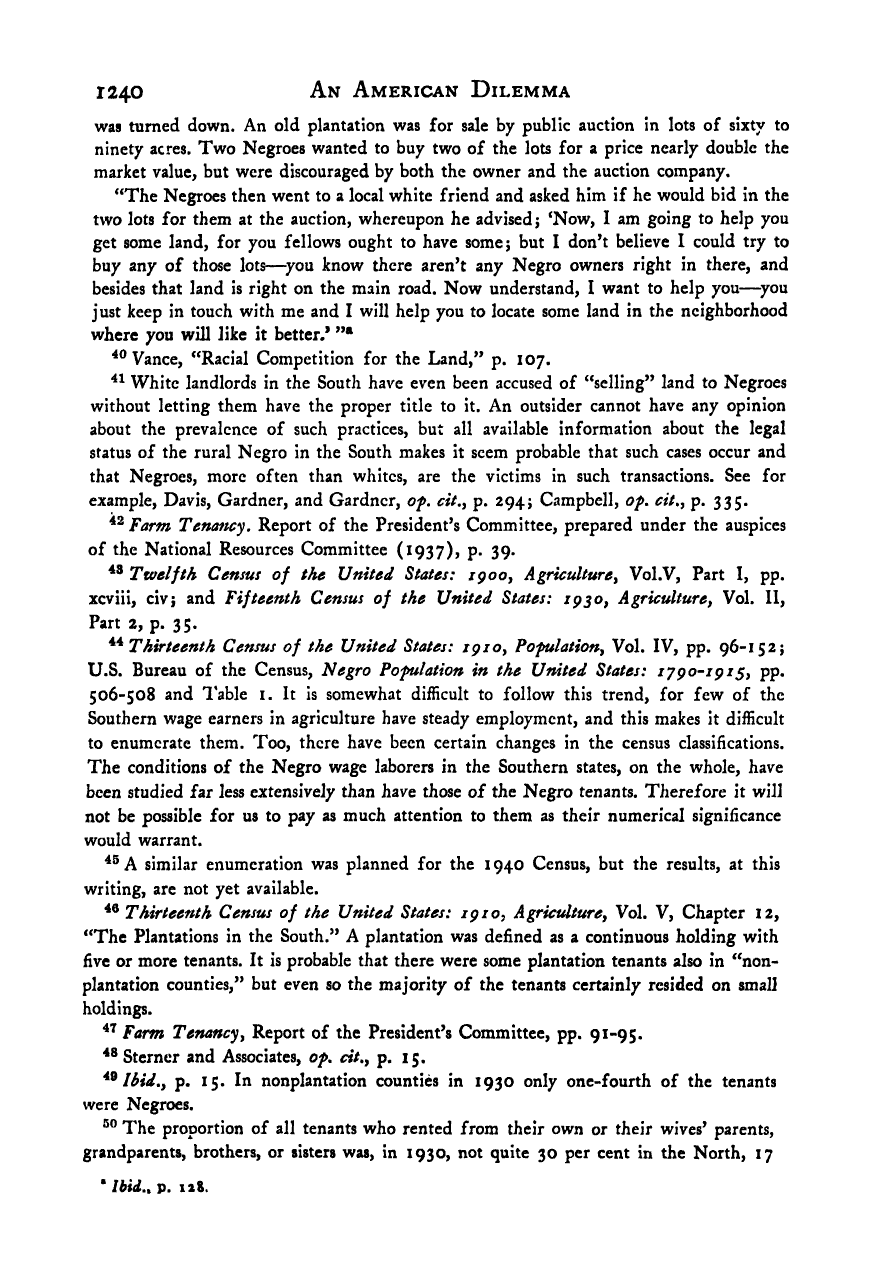Note: Gunnar Myrdal died in 1987, less than 70 years ago. Therefore, this work is protected by copyright, restricting your legal rights to reproduce it. However, you are welcome to view it on screen, as you do now. Read more about copyright.
Full resolution (TIFF) - On this page / på denna sida - Footnotes - Chapter 11

<< prev. page << föreg. sida << >> nästa sida >> next page >>
Below is the raw OCR text
from the above scanned image.
Do you see an error? Proofread the page now!
Här nedan syns maskintolkade texten från faksimilbilden ovan.
Ser du något fel? Korrekturläs sidan nu!
This page has never been proofread. / Denna sida har aldrig korrekturlästs.
An American Dilemma
1240
was turned down. An old plantation was for sale by public auction in lots of sixty to
ninety acres. Two Negroes wanted to buy two of the lots for a price nearly double the
market value, but were discouraged by both the owner and the auction company.
‘‘The Negroes then went to a local white friend and asked him if he would bid in the
two lots for them at the auction, whereupon he advised 5
‘Now, I am going to help you
get some land, for you fellows ought to have some; but I don’t believe I could try to
buy any of those lots—^you know there aren’t any Negro owners right in there, and
besides that land is right on the main road. Now understand, I want to help you—^you
just keep in touch with me and I will help you to locate some land in the neighborhood
where you will like it better.*
”•
Vance, “Racial Competition for the Land,” p. 1 07.
White landlords in the South have even been accused of “selling” land to Negroes
without letting them have the proper title to it. An outsider cannot have any opinion
about the prevalence of such practices, but all available information about the legal
status of the rural Negro in the South makes it seem probable that such cases occur and
that Negroes, more often than whites, are the victims in such transactions. See for
example, Davis, Gardner, and Gardner, of» cit,^ p. 294; Campbell, of, cit,^ p. 335.
Farm Tenancy. Report of the President’s Committee, prepared under the auspices
of the National Resources Committee (1937), p. 39-
Twelfth Census of the United States: jpoo. Agriculture^ Vol.V, Part I, pp.
xcviii, civ; and Fifteenth Census of the United States: jpso, Agriculture^ Vol. 11,
Part 2, p. 35 -
Thirteenth Census of the United States: igiOy Pofulation^ Vol. IV, pp. 96-152;
U.S. Bureau of the Census, Negro Population in the United States: lyp 0-/915, pp.
506-508 and liable i. It is somewhat difficult to follow this trend, for few of the
Southern wage earners in agriculture have steady employment, and this makes it difficult
to enumerate them. Too, there have been certain changes in the census classifications.
The conditions of the Negro wage laborers in the Southern states, on the whole, have
been studied far less extensively than have those of the Negro tenants. Therefore it will
not be possible for us to pay as much attention to them as their numerical significance
would warrant.
A similar enumeration was planned for the 1 940 Census, but the results, at this
writing, are not yet available.
Thirteenth Census of the United States: igio. Agriculture^ Vol. V, Chapter 12,
“The Plantations in the South.” A plantation was defined as a continuous holding with
five or more tenants. It is probable that there were some plantation tenants also in “non-
plantation counties,” but even so the majority of the tenants certainly resided on small
holdings.
Farm Tenancy
y
Report of the President’s Committee, pp. 91-95.
Sterner and Associates, of. cit.y p. 15.
Ibid.
y
p. 15. In nonplantation counties in 1930 only one-fourth of the tenants
were Negroes.
The proportion of all tenants who rented from their own or their wives’ parents,
grandparents, brothers, or sisters was, in 1930, not quite 30 per cent in the North, 17
* Ibid.^ p. 12S.
<< prev. page << föreg. sida << >> nästa sida >> next page >>